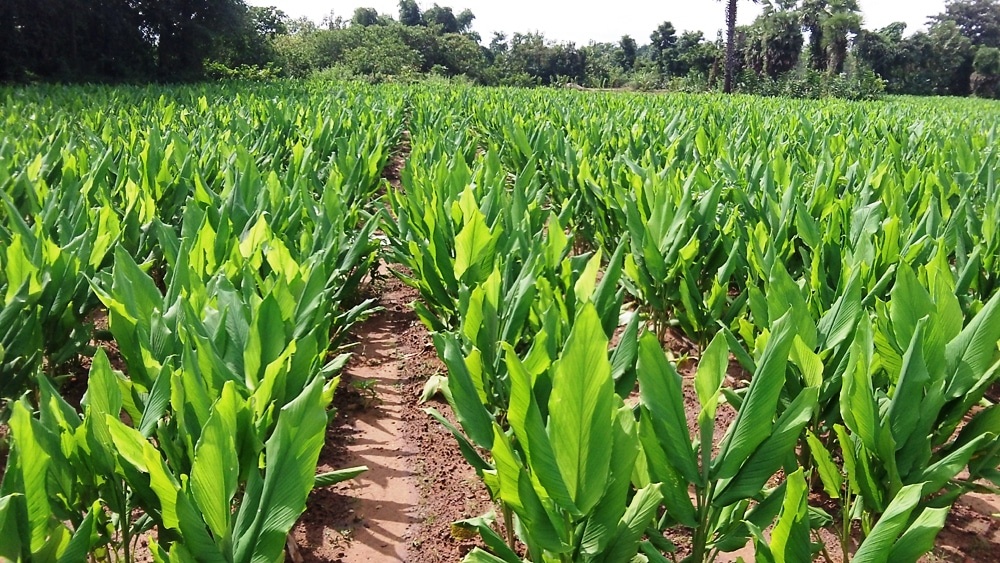Turmeric is cultivated for spice crops. Besides this, turmeric is also used to prepare many medicines. Its production is obtained in the form of tubers. People of Indian Hindu society also use turmeric in religious rituals. The rituals of turmeric are performed mainly in the atmosphere of marriage. Many unique properties are found in turmeric, which is called a beneficial thing. Its tuber contains curcumin, and allorogenin is also extracted from it. Moreover, starch is found in high quantities in turmeric.
Apart from this, sufficient amounts of protein, fat, water, carbohydrate, fiber and mineral salts are also found in it. Turmeric is also important in Ayurvedic treatment and is used in large quantities to make Ayurvedic medicines. By taking turmeric with milk, internal injuries heal faster.
Soil, Climate and Temperature
Fertile soil is required for turmeric cultivation. Turmeric production can be achieved in large quantities in sandy loam soil with proper drainage. The P.H. of the land for its cultivation. The value should be between 5.5 and 7.5. Turmeric plants require a warm and humid climate. But the hot and cold environment is harmful to its crop. Therefore, its seeds should initially have a temperature of 20 degrees to germinate, and plants need an average temperature to grow. For more farming tasks John Deere 5310 is the suitable tractor model.
Field Preparation
Before harvesting turmeric, clean the field thoroughly and prepare it. First of all, get ploughing done by planting Palau in the area. After ploughing, the field is left like this for some time. This, put 25 carts of old cow dung manure in the field and mix it well in the soil. After that, apply water in the area. After a few days of watering, when the field becomes dry, do two to three slant ploughing of the field, this will break the earthen lumps present in the area, and the soil will become friable. Finally, the field is levelled by placing a pad in the friable soil. The problem of water logging is not seen in flat areas.
As a chemical fertiliser in the turmeric field, 100 kg nitrogen, 80 kg potash, 40 kg phosphorus and 25 kg zinc are to be sprayed at the last area ploughing per hectare. After this, when the seeds have germinated, a sack n. P.K. By dividing the quantity into three equal parts, one part has to be sprayed in the field. Then, the remaining second and third parts should be sprinkled in the area for one month.
Planting Method
Two methods are used for transplanting turmeric seeds. In the first method, the seeds have to be planted on the ready bund in the field. The seeds are planted on these ridges at a distance of 20 cm. About 7 to 8 quintals of seeds are planted in one area. In the second method of sowing the roots, the seeds are put in the flat land at a distance of 15 to 20 cm, and with the help of a giant plough, they are covered with soil. Before planting the seeds, make a solution of Mancozeb and Carbendazim and treat them by keeping them for 30 minutes. After this, dry these treated seeds by keeping them in a shady place, and then transplant the seeds.
The month of May is considered to be the best for sowing its seeds. But if you want, you can plant the roots till the beginning of June. Then, the seeds get a suitable temperature to germinate during the rainy season.
Irrigation
Turmeric seeds are planted in the rainy season. Hence they do not require initial irrigation. But if there is no rain on time, water must be applied in the field. After the rainy season, the turmeric plants are irrigated for 25 days. Only 4 to 5 irrigations are done in its crop.
Weed Control
Weeding is done for weed control on turmeric plants. It is essential to remove weeds in its crop. Because the insects born on the ground cause many diseases in the harvest. Its first weeding is done 30 days after transplanting the plant, and subsequent weeding is done at 30 to 40 days. Only 3 to 4 hoeing has to be done in the turmeric crop. For use of controlling weeds Eicher 380 is another efficient tractor model.
Yield
Depending on the variety, 250 to 600 quintals are produced from a one-hectare field of turmeric. After drying, the production remains only 20 to 25 per cent. The market price of turmeric is 6 to 10 thousand rupees per quintal, so farmer brothers can easily earn up to 5 lakhs from a one-time turmeric crop in a one-hectare field.


No comments yet